#Own Network
Explore tagged Tumblr posts
Text
OWN's "Ready To Love" Returns In Brand New City Fort Worth, Texas
An all-new season of OWN’s hit series Ready To Love returns this winter as 20 eligible singles explore romantic connections in Fort Worth, Texas, as the series takes place in the historic city for the very first time.
An all-new season of OWN’s hit series Ready To Love returns this winter as 20 eligible singles explore romantic connections in Fort Worth, Texas, as the series takes place in the historic city for the very first time.
About OWN’s Ready To Love
Hosted by comedian and actor, Thomas “Nephew Tommy” Miles, the dating series explores the real-life romantic rollercoasters of successful and striking…
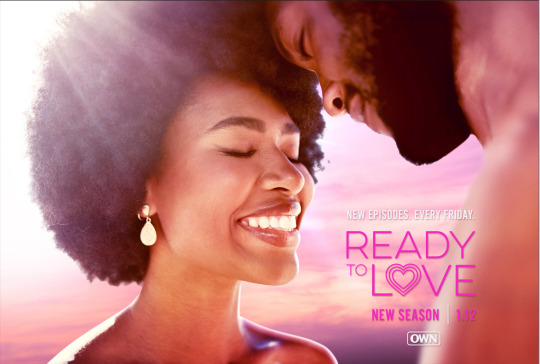
View On WordPress
0 notes
Text

Pushing my ART is a giant scary spider agenda
#it just makes sense to me#scary to humans but harmless unless threatened#very smart#all powerful in its own defined space#like the whole first half of artificial condition is a spider (ART) trapping a fly (SecUnit) in its web#and then becoming best friends with it#ART drone to me also looks like a spider#I'm not even that into spiders personally this is just real to me#murderbot#they are watching worldhoppers#the murderbot diaries#murderbot fanart#asshole research transport#perihelion#secunit#network effect#artificial condition
2K notes
·
View notes
Text

Time Of Essence is here. As OWN prepares to take viewers through ESSENCE’s 50-year legacy, examining each decade’s highlights every week, we accompany readers on a similar journey of our beloved publication’s most unforgettable covers, beginning with the magazine’s inception in 1970.
The 1970s were a transformative decade for ESSENCE, as it played a crucial role in shaping the representation of Black love and beauty across its monthly periodicals. Throughout this era, the magazine’s covers and content captured the essence of the time, reflecting the changing social and cultural dynamics within the African American community.v
#brandi bates#brandi l. bates#author brandi l. bates#american authors in europe#books#Essence Magazine#OWN Network
0 notes
Text



had a dream about fool!sumi and traitor!taba
#p5#persona 5#sumitaba#p5r#kasumi yoshizawa#futaba sakura#sumire yoshizawa#gryffin's aus#foolsumi got actualised and you play as ''kasumi'' for the main game before waking up as sumi#dialogue options and mannerisms start to veer towards reading more pessimistic/downtrodden where kasumi would be upbeat#futaba is a child star/actress who appears on a lot of variety/talk shows#her whole thing at first is that while she has an amazing stage presence/real acting skill#as soon as shes not in front of a camera she has really bad social anxiety#then it turns out that she knows about the metaverse i havent figured out exactly how#but probablt through her mom#and now is a hired killer through the metaverse. doesnt work for shido by the way. all her networking and intel is her own#and she is nooooot happy about these upstart phantom thieves running in HER turf#leblanc takes the place of jazz jin as the place she brings sumi in her confidant#the varsity jacket in her 3rd sem outfit is soujirous :)#i think thats all the little details i had
549 notes
·
View notes
Text
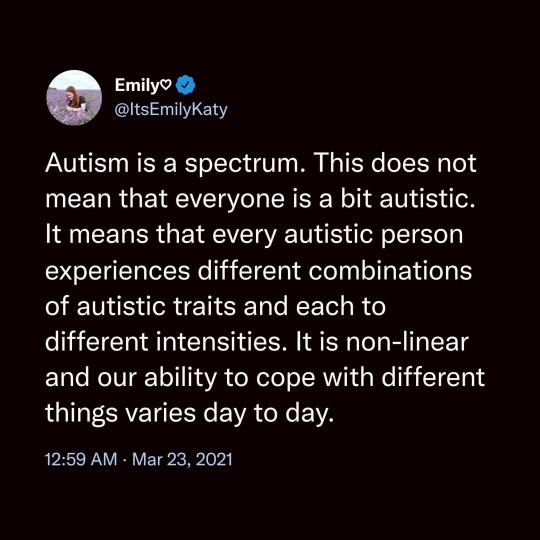
I wish more people understood this. Autism affects everyone differently. And this means every single individual.
I CAN Network Ltd
#autism#actually autistic#autism is a spectrum#no one is “a little autistic”#every autistic person is different#and experience the world in their own ways#I wish more understood this#neurodivergence#neurodiversity#actually neurodivergent#feel free to share/reblog#I CAN Network Ltd (Facebook)
2K notes
·
View notes
Text
Best part of Durgetash to me is that according to the "Memoirs by Gortash" chapter 4 outline you can find in his room in Wyrm's Rock, he and Durge were hanging out doing heists even before Bhaal and Bane commanded them to be allies and before Gortash came up with the Absolute plan. Gortash was just a Dead Three cult leader who saw Durge leading their own Dead Three cult and went "same hat?" And offered to help them steal back a bhaalspawn's remains + some torture devices from the House of Wonders purely to make friends.
#bro was networking. making friends of his own volition#he didn't even know about the mindflayer colony or the elder brain. he just heard about another cult leader (an ACTUAL bhaalspawn!!)#and decided he wanted to be friends. wholesome#bg3#durgetash#enver gortash#the dark urge#durge#gortash x durge#baldur's gate#baldur's gate 3
3K notes
·
View notes
Text
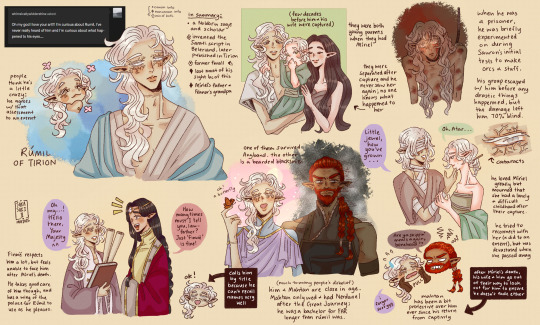
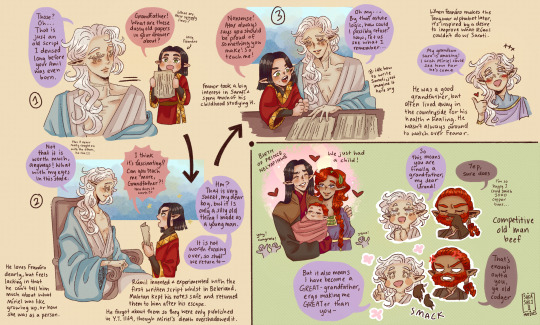
some rumil doodles in response to @whimsicallywiddershins who asked: Oh my god I love your art!!! I'm curious about Rumil. I've never really heard of him and I'm curious about what happened to his eyes....
thank you for the ask!!!! im real happy to hear you like my art, and even happier you took the time to ask about rumil! <333 it took me until your ask to realise that, despite him frequently appearing in group concept sketches n doodles, i've never really elaborated on him haha 😅 i tried to illustrate and summarise some of the key points in the art, but more detailed yap incoming under the cut!
so! to start off, my version of rumil is pretty much at his core the same as canon rumil wherein he's a noldorin sage/scholar responsible for inventing the Sarati and later going on to write the Annals of Valinor. his whole being captured and enslaved in angband for a while comes from the other version of him the Book of Lost Tales, where he was a slave of Melko who learned the speech of monsters and goblins --essentially i thought it'd be fun to combine the two to give him a more complicated backstory ^^
in response to your query about his eyes, i hc that during his time in angband he was one of those who were experimented on by Sauron - acting on Morgoth's orders - during the initial testings for the evolution of elves -> orcs. (maybe sauron thought that blinding the first elf-orcs would make them more unlikely to disobey orders/easier to control? hmm) his band of captives were able to break him out in time and they fled back to safety before he was too far-gone, thus allowing him to reunite with finwe, miriel and co, and then eventually follow Orome to valinor :D
him being miriel's dad was also something i felt would be fun to explore, especially because i thought his ties to Sarati and Feanor would be an interesting dynamic! it's very very much noncanon, and incredibly self-indulgent on my part (im so sorry... ���), but i like to go on tangents abt their relationship! i think rumil wouldve made attempts to dote on feanor and encourage his linguistic pursuits, but would have been held back a lot on truly being around him by both his health and his lingering guilt about miriel. he is incredibly proud when feanor refines his abandoned Sarati concepts and turns Tengwar into a near-universal system of writing however :D
other thoughts on rumil... hmm... i think he's kind of pitiful tbh. something about him being an absent (albeit not of his own volition) father to miriel, and then in turn him feeling unfit to offer feanor as much emotional support as would be ideal, is a theme i would like to keep exploring (^3^) adding on to the fact that he outlives his wife, daughter, son-in-law, grandson, and like 6/7 of his great-grandsons while miraculously not Fading himself gives him an essence with parallels to maglor that i do appreciate...
major apologies for going off on such a rambly tangent, but i do suppose an explanation on my rumil has been overdue for a few years!! i hope i havent misled anyone since i first drew him in that family tree, but thank you so much again for taking the time to ask about him! im always grateful for the interest in my absurd headcanons, and i hope you have a wonderful weekend ahead!!! ❤️
#silmarillion#rin replies#whimsicallywiddershins#rumil#feanor#finwe#miriel serinde#mahtan#(and technically)#maedhros#he may be incredibly jaded but he has a good helping of joyous whimsy :D#i imagine he started writing the Annals after the Exile as his own way of doing *something* and not feeling powerless like he did ->#(cont) in the many decades following miriels death.#i also have thoughts on Sarati and its possible evolution into a system of braille that he mightve facilitated at some point...#maybe he becomes a teacher later at some point... professor rumil? ...maybe ive been brainrotted by hsr and the recent anaxa content heh#on a different note rn i have so many wips of sauron for some reason so... next few posts might be an influx of him? ToT#i still have a tar mairon page i did in december i havent posted hahahaha...haha.... ha.......#but ill keep working on answering asks slowly but surely 😤#silm#noldor#sketch dump#rumil of tirion#silm art#elves#the silmarillion#sakasakart#textual ghosts#headcanons#credit to cartoon network for sparkly bg as always
255 notes
·
View notes
Text










betrayal & heartbreak
my own private idaho (1991) // challengers (2024) // trainspotting (1996) // the social network (2010) // mulholland drive (2001)
#are we seeing the vision?? let me cook#cinema#trainspotting#tsn#the social network#mulholland drive#my own private idaho#mopi#challengers#tsnedit#challengersedit#trainspottingedit
285 notes
·
View notes
Text
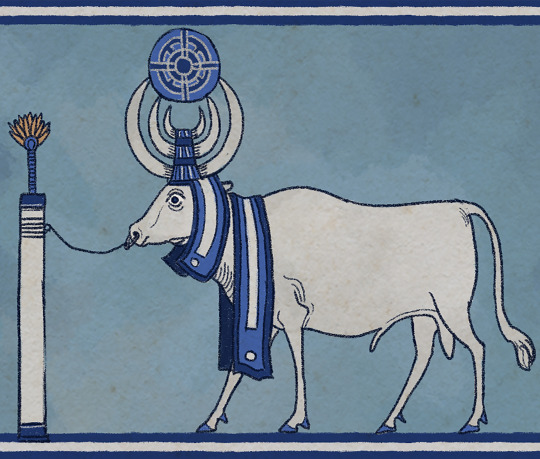
The god Od depicted in a symbolic representation of the word's creation as a docile bull awaiting sacrifice at the altar.
It carries the foundations of the world in its horns (via a very old cross and wheel motif representing cyclical totality, now mostly used as a visual shorthand for the world). It has three sets of horns in the form of the lunar crown, a mostly obsolete symbol of Wardi royalty. The altar is decked with an orange lily motif, after a hardy native water lily capable of regrowth in waters that dry seasonally. This symbol of rebirth and fertility in a sacrificial scene evokes the sacrifice-rebirth cycle initiated by Od's primordial slaying, which is fundamental to the world's functioning.
This is a rundown on interpretations of the god Od, a deity that has a long history in the lands surrounding the Mouth of the eastern inner seaway, and the impact (or lack thereof) of its primordial sacrificial nature in religious practice.
The god Od appears in religious practices throughout the region, having the utmost significance to the Imperial Wardi faith and lesser or separate significance elsewhere. The five religious practices wherein variants of Od has longstanding historical significance are the Burri Faith, the (Imperial) Wardi faith, the Old or 'Heathen' Wardi faith, the faiths of the Hill Tribes, and the Wogan faith.
—
The name Od and most significant elements of this god have origins in the Burri faith, which was transferred across the sea to the Wardi, Wogan, and Hill Tribes in the time of its second and third empire.
The Burri Od is described as having been the first being. The universe began as a cosmic sea and empty, eternal sky, loosely representative of a primordial and fundamental female and male dualism. Od appeared at their borders as a result of their interfacing, in the form of a giant aurochs or bison whose hooves touched the seafloor and horns touched the sky. He dipped his head down to the silt and lifted it out of the sea in his horns, thus forming the foundations of the world. His semen spilled into the cosmic sea and created the first seven gods, who then killed and divided their father, giving the world its form with his body.
While significant to the creation story, Od is of relatively little importance in everyday practice of the Burri faith and is not commonly worshiped (rather his seven children are, as they were the original and most powerful group of gods and created life).
Though the Burri Od takes on a sacrificial role in creation, animal sacrifice is not central to the Burri faith and is only performed in specific contexts (some festivals and holidays, in times of great strife, and to a few specific gods within a wide pantheon). The Burri faith does not involve a sacrifice-rebirth cycle as foundational to the world's functioning and god's health, and offerings are instead mostly gifts to please and rightly venerate the gods (or avert the malice of less savory deities). Offerings of food, drink, and precious materials are preferred by most gods. When animal sacrifice does occur, bulls ARE generally favored, as a reflection of their primordial counterpart.
—
The modern/Imperial Wardi Od is partly an import of the Burri tradition, which fused with both native monotheistic/animist worldviews and animal cults during the reign of the 2nd Burri Empire and developed into a new faith, which has presently become the state religion of the Wardi Empire.
‘Od’ in the Imperial Wardi context is best translated as capital G ‘God’ (anyone saying 'God' is, in-universe, saying the word 'Od'). Its creation of the world plays out in a very similar fashion, but the first human life (rather than other gods) is created by Its semen mingling with the cosmic sea. It willingly sacrificed Its body at the hands of the first people, who formed the world with its remains. Its shed blood spattered the earth and can be found today as meteoric iron, and animal life emerged from the mingling of the blood and the soil. Its death initiated the eternal cycle of sacrifice/death and rebirth, with each begetting the other and necessary for the world to function.
Od's body is dead and the world is Its corpse, but Its spirit survives in seven 'faces' which govern specific functions of reality and society. The connection of Its spirit to Its body is maintained by right practice, right prayer, and right sacrifice (in the form of food/drink offerings, bloodletting, common sacrifices of animals and occasional sacrifices of people).
The Imperial Wardi Od is generally regarded as genderless and dual-sexed, and referred to with a unique deified pronoun most effectively translated as capital I 'It'. Its sex is of relatively little significance to everyday religious practice, and discussions of Its dualism are more likely to occur in scholarly and philosophical contexts (like debates on the minutia of how Its semen, milk, and menstrual blood are all mentioned in old accounts of creation, and how the implications of this should translate to body politics and taboo).
—
The Old Wardi or ‘Heathen’ Wardi faith is a separate branch of old ethnic Wardi religion with significantly less Burri influence. This is a minority practice that only survives intact in isolation. Its practitioners are often hostile to all foreign influence and the Imperial Wardi faith, and suffer minority status and religious suppression.
Its version of Od is a more intact surviving remnant of ancient Wardi monotheism, as an androgynous creator god who lost physical form in the act of creation, and lives on as innumerable spirit aspects of its whole. This deity is referred to as Od in describing its primordial form, but is mostly referred to as a unique word for spirit, which is 'the Koya'. Practitioners of the old faith often identify the seven-faced Od as a twisted, foreign misinterpretation of the Koya.
This practice is somewhat animistic in nature and involves veneration of individual spirits that form a larger whole. Every aspect of the world has a spirit (plants, animals, minerals, bodies of water, etc) that exist in an ideal balance and as strands of an interconnected death-rebirth cycle. Each spirit is referred to as 'the [noun]-koya'. All discrete forms of life/matter have at least one attached Koya, while living beings also have a soul (which is separate from the Koya and reincarnated upon death).
Each Koya exists as a quintessential essence (ex: the lion-koya, the maize-koya, the iron-koya, the salt-koya) rather than separate individual objects having separate individual Koya, though unique landmarks do have their own (the Brilla River-koya is separate from the Yellowtail River-koya, though both share the freshwater-koya). Each individual may have multiple spirits (geese have the goose-koya, but also the bird-koya, the freshwater-koya, etc), a system that categorizes the world by intrinsic natures and precisely dictates how each physical body has unique metaphysical significance.
Animal sacrifice plays a somewhat similar role in Old Wardi religion to Imperial Wardi religion in the sense that it intends to maintain the stability and oneness of the divine spirit and a death-rebirth cycle. In this case, in freeing part of the spirit, balance can be brought to the Koya totality and restore the death-rebirth cycle. (Ex- in times of drought, the sacrificial release of the migratory goose-koya can encourage the return of the rains). This is far from the only way to re-balance the Koya. The most significant rites come in the form of songs that summon, release, or expel individual Koya as needed.
—
The Od of the Hill Tribes is a mingling of the Burri/Wardi Od and a much older goddess of fertility and agriculture, and is strongly associated with cattle and barley. This version of Od did not create the world and is only one of many gods, though she is said to have been born from the sea and carried up fertile soils with her (which is likely a direct result of Burri/Wardi influence). A few tribes venerate Od as a chief or patron god, though none are fully monotheistic (outside of converts on individual or clan levels).
She has a distant common ancestor with the Finn goddess Morgren (as the various Hill Tribes are descendants of a single proto-Finn population who migrated across the Viper seaway in prehistory), who is also a goddess of agriculture associated with fertility and barley (though in Morgren’s case, she is THE god of the staple crop barley and lacks the cattle association, and has no direct influence from the Burri/Wardi Od whatsoever)
Most of the tribes of Greathill do not practice animal sacrifice but offer grain and fruit to Od, and create a sanctified mix of crushed barley and oil that is anointed on livestock and people to confer Od's blessings of fertility. In some cases, the dominant cow in each herd is considered to belong to Od and will not be milked or slaughtered, and is buried with full rites upon its death.
—
The Od of the Wogan religion is distant to the rest of her counterparts, though has absorbed some Burri and modern Wardi elements over time and is referred to by the same name (a definite foreign import). She shares the fertility aspect ubiquitous to other Od variants, and is occasionally depicted as a cow.
She is a goddess of the earth and sea, who was wed to Iapedi, the god of the sky. The ocean is functionally her womb (which may be trace Burri/Imperial Wardi influence, or merely coincidental) and all life emerged from within.
These are the only two true gods to the Wogan, though there is an additional element wherein the mating of Od and Iapedi also created innumerable spirits found throughout nature that act as an animating life-force. The concept is very similar to the Old Wardi '-Koya' (as the two faiths had close common ancestry), though this one lacks the sort of taxonomical system of its counterpart, and only ascribes spirits to living things. Each spirit in the Wogan religion is distinct (rather than each type of animal, plant, etc potentially having multiple spirits), and the spirits existing in each body are part of a greater whole that exists as a sentient consciousness that can be communed with (ex: each lion has A lion spirit, all part of The lion spirit, the latter of which can be engaged with).
Wogan religion strongly retains ancient animal cult practices common across the ancient Wardi-Wogan sphere, some of which have been translated into the faces of God in the Imperial Wardi context (both religions share commonalities of lions, snakes, albatross, migratory ducks, and cattle being significant sacred animals). The function of animal worship to the Wogan is communication and interface with the greater spirit of each animal (which can range anywhere from gaining personal blessing and protection, to dispelling plague, to 'lay off on eating our crops').
The Wogan faith does not involve animal sacrifice (though ancient variants almost certainly did). This is connected to traditional vegetarianism among the Wogan (as a means to avoid offending animal spirits), which some view as a point of pride and a mark of distinction against their Imperial Wardi majority.
#I don't remember my own tagging system....whatever#blightseed#Should be noted that there are other religions that have adopted Od in various capacities as a result of the Wardi Empire's#expansion/role in the trade network/immigrant communities#But these are very recent adoptions whereas the five of this post have Od influences going back almost a millenia
414 notes
·
View notes
Text

my mom deserves better than this
#ao3#archive of our own#i actually haven't checked to see if it's back up#i was at work and ao3 is blocked on the work network
80 notes
·
View notes
Text
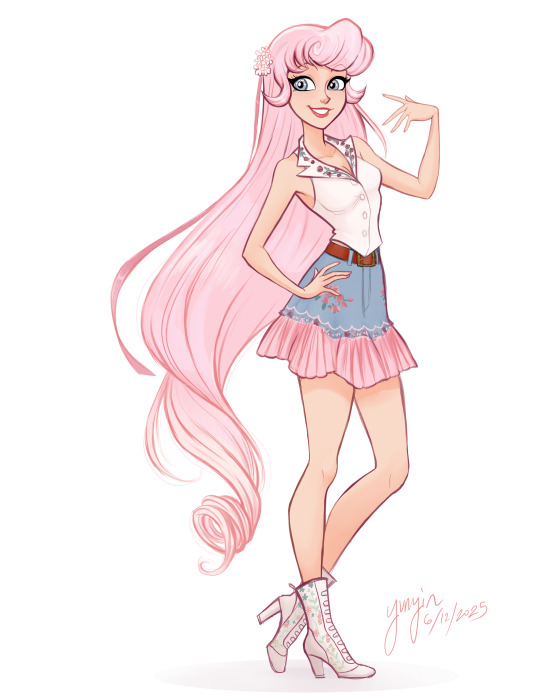
Commission for Tg-Anon44!
#yunyinart#colored sketch#commission#pink hair#I am slightly swamped with work atm so I don't have a lot of finished fandom things to post here#but I hope you like this too!#a lot of these are redrawing adopts#and the artist who did this original design did such a fun job it was hard to make one in my own style!#it was like a hybrid of old cartoon network and retro disney#Super cool
71 notes
·
View notes
Text
I know that most takes about people not deserving to have children are rife with eugenics (eg: poor people shouldn't have kids, mentally ill people shouldn't have kids, etc) but that said, nobody is ever entitled to having children, like having kids isn't a human right that must be obeyed, a kid is not a thing to own but a vulnerable life that you're responsible for and who actually has human rights that you're ignoring by putting yourself and your desire first rather than your reality and situation
#and sure money is a huge aspect but mostly its having a social network that supports you through parenthood bc you might not be well off but#if you have a family thats with you and you try your danmest hard to give the best you can for them theyre going to be happy and healthy#but then again each case scenario is its own theres no set recipe and parents with lots of resources continuously fuck up their kids#if you're all alone in this world and you decide to have a kid to cover it up then your kid is also going to be all alone in this world#boluda tag
73 notes
·
View notes
Text
Sabrina Wallace speaking on Technology that has been around for at least 20 years such as WBAN (whole body area networks)
If you don't know who she is, this rabbit hole is deep.
Her rumble account👇
Happy Digging 🤔
#pay attention#educate yourselves#educate yourself#reeducate yourselves#knowledge is power#reeducate yourself#think about it#think for yourselves#think for yourself#do your homework#do some research#do your own research#do research#ask yourself questions#question everything#sabrina wallace#wban#whole body area network#the internet of things#news
139 notes
·
View notes
Text
Echo is proof that someone out there cares. There will always be people who care and will fight the good fight and will come when they are called. They will go where there are needed. Someone out there is seeing injustice in the world and is doing the work to ensure that as many people as possible can be saved, can be given a chance at a life.
Despite the fact that he's suffered so much already he didn't hang it up and check out. He knows suffering, understands it, and never wants it to happen to anyone else. Everything he went through never made him cold or callous. It didn't make him apathetic to the plight of others. Instead his suffering only made him kinder, stronger, wiser. He knew the clones were suffering and instead of hiding, instead of checking out when he could have, he decided he was going to rescue them. Someone came for him when he needed them. He will do the same for others. And he's connected to a whole network of clones fighting for the same thing. Forming a community, protecting people, creating a life for the clones and making that possible even in incredible dark times.
That feels really difficult to believe sometimes. That someone out there does actually care and will actually do something. But those people exist. There are more of them than you think.
Echo is proof that good still exists. That someone will be in your corner. That no matter what happens you'll always have an ally who will risk everything to give others a chance to survive. The clones have always been such a main focus for him, people he cares so deeply about. He could never sit idly by and let them be experimented on and die at the hands of the empire.
In a galaxy that has forgotten about the clones Echo never has.
#tbb echo#the bad batch#arc trooper echo#echo bad batch#space chatter#Echo is the best character in that entire damn show and he proves it over and over again#Echo proves every day that he is a kind hearted and loving individual#he is noble and loving and brave and loyal#he is everything I wish I was and everything I hope to be#he suffered and he knows suffering and he doesn't want it to happen to anyone else#I just want to give him and Rex and the clone network credit for how wonderful they really are#they need their own damn show#fuck it might write a little story about Echo holding a clone's hand and talking him through what's happened and what's happening next#freshly rescued from the empire and terrified#but there is Echo#holding his hand and telling him it's okay that it happened to him that there is a way forward#if someone wants to read something like that
137 notes
·
View notes
Text
I love the idea of someone with the kink who teases their partner by interrupting their sneezes, because they think it’s cute how disgruntled they get when they lose them. Then, to show how “sorry” they are, they help them induce to relieve that stuck sneeze feeling, almost as if getting to be the one in charge of when and how they sneeze had been their plan all along.
#my brain is on this channel 24/7#hbn (horny bitch network)#yall know who I’m thinking about but insert ur own#it’s so fun when one of the characters has the kink#something sweet and fun about writing the vanilla perspective but dear god#incorporating the kink really elevates that shit
70 notes
·
View notes
Text
i need you all to know that this is ALL i've been thinking about for the past 2 days 😭
#ANDREW AND JESSE IN 2025??! IN FRONT OF MY VERY OWN EYES 😭#the smiles on their faces i am SOBBING#oscars 2025#andrew garfield#jesse eisenberg#jewnicorn#markwardo#the social network
79 notes
·
View notes